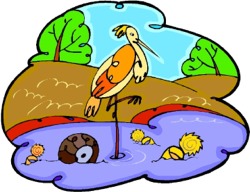 Natural
World Natural
World |
Research Process
Directions to Students
Scenario
"Wild"
I am a human child.
The earth was here before we came
and wild!-wild!-wild!
The wild things said goodbye.
because we took their homes away,
and die!-die!-die!
Before the earth is through
We have to make it green again-
So do!-do!-do!
The elementary students in your area are concerned about environmental problems and would like to be able to do something to help. Your school would like to create a website discussing important environmental problems and possible solutions. This website would enable elementary students and their families to access information about environmental needs and what they might do about them.
|
Task and Product

Design a mock-up for a web page with visual as well as written information about an environmental problem you have identified which can be included on your school's website.
Before you begin, you should think about an environmental problem that has meaning for you and that problem's long-term effects.
Assessments

You will be graded on your daily work on the research process as well as on your final product.
Question
|
Think about what is currently being done about an environmental problem and what still needs to be done, what students your age can do to help, and what resources are needed and available to help students achieve their goal. |
- What is acid rain?
- What impact does acid rain have on the forests in Canada?
- How would acid rain effect the Chesapeake Bay?
- Is there a need to make laws to lower the amount of acid rain?
- Which solutions have been tried to lower the amount of acid rain?
- Justify which solutions you think should be tried to decrease the amount of acid rain. Why?
Gather and Sort

|
Sort your findings using a graphic organizer when taking notes.
Remember to cite your references. Check the MLA guidelines and examples for citing resources; however, your school may use a different format.
![]() To avoid risking plagiarism,
properly paraphrase and quote in your writing.
To avoid risking plagiarism,
properly paraphrase and quote in your writing.
Organize

Click here for help analyzing your research notes to determine if you have answered the essential question.
| Think about what is currently being done about an environmental problem and what still needs to be done, what students your age can do to help, and what resources are needed and available to help students achieve their goal. |
Click here for help synthesizing your findings.
Before you begin, recall the items you were asked to consider in planning your report; a visual, long-term effects, current solutions, problems still to be solved, students' help, and resources needed.
Begin crafting and refining the report you will share on your school's website.
Click here for help creating your final product.
Click here for help evaluating the effectiveness of your webpage.
Present your web page to your class as directed by your teacher or library media specialist.
Reflection
Take time to think about the research process you just completed.
Follow these guidelines to help you to prepare your I-Search report and reflection.
Story of my I-Search process...
- What changes did you make to your original plan?
- What worked and what didn't work?
- What did you learn about yourself as a researcher?